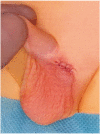Abdominal Cryptorchidism with Complete Dissociation between the Testis and Deferent Duct Mimicking Testicular Regression Syndrome
- PMID: 36832334
- PMCID: PMC9955419
- DOI: 10.3390/children10020205
Abdominal Cryptorchidism with Complete Dissociation between the Testis and Deferent Duct Mimicking Testicular Regression Syndrome
Abstract
Complete separation of the deferent duct from the epididymis in cryptorchid testes residing in the abdomen is an extremely rare variant of developmental disorders of the testis and epididymis. Available sources mention only three clinical cases similar to our observations. The unique anatomic aspects of this disorder hamper the correct diagnosis of an intra-abdominal cryptorchid testis. Two boys with nonpalpable left-sided cryptorchidism underwent diagnostic laparoscopy, revealing an intra-abdominally located testis. The epididymis was completely separated from the deferent duct, and the epididymis and testis were supplied by testicular vessels. Exploration of the inguinal canal revealed blind-ending deferent ducts. The testis was brought down through the inguinal canal and fixed in the scrotum in both boys. The follow-up examination at 6 months revealed no signs of testicular atrophy or malposition of the testis in either patient. With our observations in mind, the exclusive use of a transscrotal or transinguinal approach as the initial surgical exploration in the treatment of patients with nonpalpable forms of cryptorchidism may be inappropriate. Careful laparoscopic examination of the abdominal cavity is indispensable in children with suspected testicular regression syndrome or nonpalpable forms of cryptorchidism.
Keywords: abdominal cryptorchidism; deferent duct; dissociation; epididymis; malformation; testicular regression syndrome.
Conflict of interest statement
The authors declare no conflict of interest.
Figures






Similar articles
-
Surgical management of the nonpalpable testis: the Children's Hospital of Philadelphia experience.J Urol. 1998 Apr;159(4):1340-3. J Urol. 1998. PMID: 9507881
-
The management of nonpalpable testis with combined groin exploration and subsequent transinguinal laparoscopy.J Urol. 2002 Feb;167(2 Pt 1):674-6. doi: 10.1016/S0022-5347(01)69122-5. J Urol. 2002. PMID: 11792951
-
Complete testicular epididymal dissociation in the abdominal cryptorchid testis.J Pediatr Urol. 2013 Dec;9(6 Pt B):1023-7. doi: 10.1016/j.jpurol.2013.02.017. Epub 2013 Jun 2. J Pediatr Urol. 2013. PMID: 23735659
-
Surgical Management of the Undescended Testis: Recent Advances and Controversies.Eur J Pediatr Surg. 2016 Oct;26(5):418-426. doi: 10.1055/s-0036-1592197. Epub 2016 Sep 15. Eur J Pediatr Surg. 2016. PMID: 27631723 Review.
-
Laparoscopy for nonpalpable testis in childhood: is inguinal exploration necessary when vas and vessels are not seen?Eur J Pediatr Surg. 1996 Feb;6(1):7-9. doi: 10.1055/s-2008-1066456. Eur J Pediatr Surg. 1996. PMID: 8721168 Review.
References
-
- Hrivatakis G., Astfalk W., Schmidt A., Hartwig A., Kugler T., Heim T., Clausner A., Frunder A., Weber H., Loff S., et al. The Timing of Surgery for Undescended Testistestis—A retrospective multicenter analysis. Dtsch. Arztebl. Int. 2014;111:649–657. doi: 10.3238/arztebl.2014.0649. - DOI - PMC - PubMed
Publication types
LinkOut - more resources
Full Text Sources

